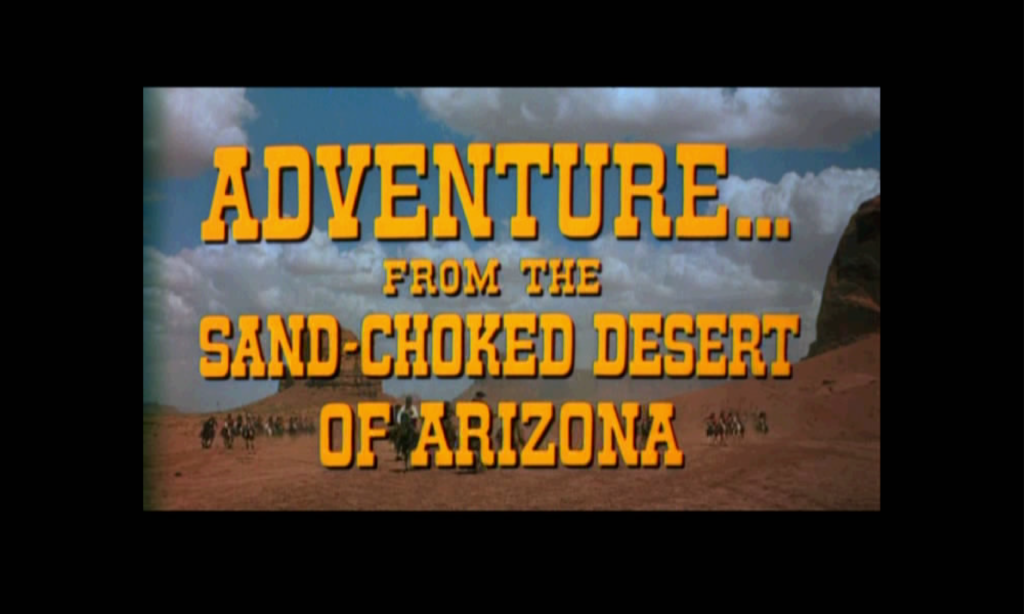John Ford’s The Searchers is a Western about party of white settlers pursuing a Comanche band that has slaughtered a homesteading family’s males and adults and kidnapped the family’s two daughters. The film presents a question that has puzzled me for years: How is it that a film so glaringly flawed can be so powerful, so great? And it is great. In 2008, the American Film Institute named it the best Western ever made. The same year, Cahiers du Cinéma ranked the film the tenth best film ever made. In 2012, a Sight & Sound survey of international film critics ranked it the seventh best film of all time. Its influence has been noticed in and/or acknowledged by directors as different from one another as David Lean, Sam Peckinpah, Martin Scorsese, Sergio Leone, George Lucas, Jean-Luc Godard, Steven Spielberg, Wim Wenders, and Paul Schrader. It has been an object of intense analysis by numerous scholars. (Anyone interested in reading in-depth work on the film would do well by starting with Edward Buscombe’s monograph in the excellent British Film Institute series of slim but comprehensive, well-researched, and annotated volumes on individual films.)
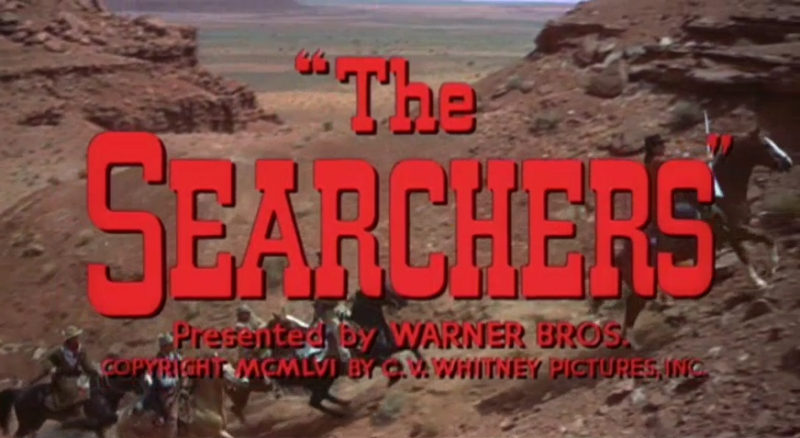
But if you’ve seen the film many times, as I have in my career as a film teacher and occasional filmmaker, the list of mistakes, instances of laziness, and uninspired directing seems to grow with almost every screening. The funniest goof is a desperately inhaling corpse, probably a result of the actor playing the corpse running out of breath just before the massive stone under which he is buried is lifted. Was Ford distracted or delayed before shouting “Action!”? Another howler — if you notice it — is an automobile on a hillside in the distant background of a cavalry fording a stream. You can’t see the car or truck itself, only its headlights. And, either because the driver suddenly noticed the filming below or a frantic production assisted finally hailed him, the vehicle stops (with its lights still on) mid-frame.
These are the kinds of mistakes that often happen on a shoot. They’re corrected by retakes — if they are noticed. The Searchers was filmed before video technology enabled a director to immediately check at least a video representation of what he or she had just shot. John Ford would not have seen these scenes on film until a couple of days later at the earliest, after the 35mm rushes were developed and sent to him (if he even bothered to look at rushes while on location). At that point, to re-shoot likely would have been costly in time and money. Or maybe Ford noticed them but just shrugged. Most audiences of the finished film don’t notice them unless someone points them out. The very experienced Ford probably would have known this to be the case.
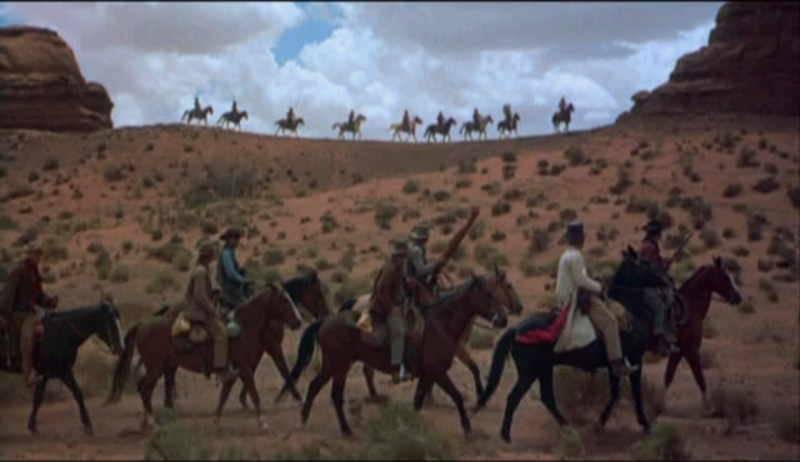
A more cinematically interesting lapse occurs early in the film, when a Comanche band traps the search party in what looks like an inescapable pincer movement. The impending chase is set up beautifully in two gorgeous shots. On the searchers’ left, Comanche warriors on horseback appear atop a ridge and against a bright blue sky and start following the search party. To the searchers’ right, another group of Comanche warriors are following them from along the base of a huge sandstone butte. A river lies ahead. We know a chase is about to begin, and it looks like the search party has no chance of escaping. But once it starts, the chase itself violates the fundamental rule of filming a chase, which is that the pursuers and the pursued have to appear in a few shots by themselves, not together. Separating them in some shots allows the editor to manipulate time and thus both build suspense and make plausible either the escape or the capture. This manipulation of time, of pacing, is possible because while we are watching one party, we don’t know how much the other is pulling away or falling back. Therefore, when we see them again together in the same shot (if we do), we have little or no problem accepting that the pursued have escaped or been overtaken. But this chase in The Searchers has only two shots in total, each static, and each including both parties. At one moment, the Comanche seem only a few feet from overtaking the fleeing search party, and at the very next, instantaneously about a hundred yards behind them, allowing the fleers to cross the river and start shooting back. A few shots of the two parties separately would have enabled the editor to make the escape seem both believable and more suspenseful.
It cannot be that Ford didn’t know what he was doing. Ford earlier had proved himself a master at filming chase scenes. The spectacular climactic chase in Stagecoach (1939) lasts nearly nine minutes, employs more than a hundred shots of constant motion, contains daring stunts, and includes numerous shots of only the pursued and of only the pursuers. Many of the shots are tracking shots, the most dynamic of standard camera movements. In 3 Godfathers (1948), Ford constructed an elegant, minimalist 13-shot chase scene that can serve as a demonstration of how to film a chase. In this scene, occurring in a desert, he separates the fleeing outlaws and their pursuers in most of the shots. All but three of the shots are tracking shots. One of the tracking shots is a point-of-view shot, another a plot-important close-up of a bullet piercing the outlaws’ only water bag. Ford concludes the chase with a pair of gently deescalating pans. The viewer accepts that the outlaws have gotten away. Given Ford’s mastery of the chase, it’s hard not to suspect that by the time of The Searchers, he felt something like “been there, done that,” and was perhaps after bigger game.
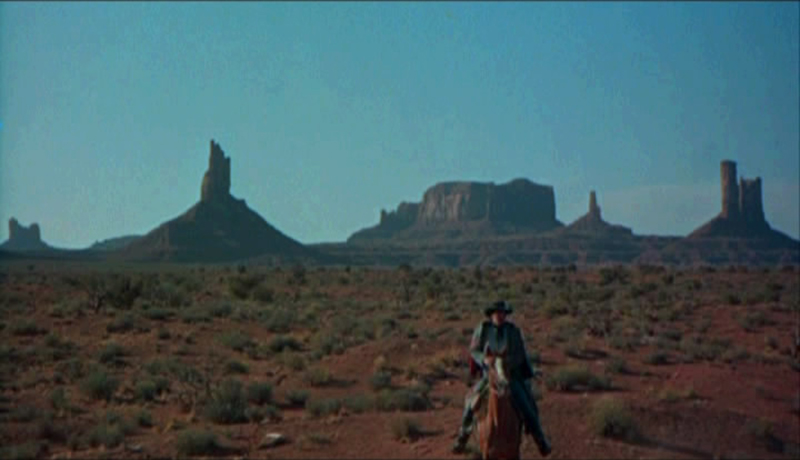
There are numerous other weak moments in the film, of which I’ll mention only a few: often poorly paced, woodenly delivered dialogue; occasional histrionic or amateurish acting; an obese, 30ish-looking Comanche woman described not ironically in a letter as little and very young; the head of a character peeping over the top of a background sand dune waiting for her cue to enter the scene running; a white actor playing Chief Scar; and a setting identified as Texas but obviously Monument Valley, a good 200 miles from the westernmost edge of the state.
But the list of things that are great about The Searchers is also long, and the items on that list far more important. The use of Monument Valley is justified not just by its sheer stark beauty — to my knowledge, it has not been photographed more lovingly or looked so magnificent before or since — but also its appropriateness to the film’s story and scratch gravel characters. At times, the windblown sandstone buttes seem to echo the protagonist Ethan’s rugged features. And there is a metaphorical sense that Ethan materialized out of this menacing but indifferent (to humans) landscape and returns to it in the end.
Ford’s unobtrusive style yields a number of extremely moving scenes. The best of them involves the Reverend Captain Clayton, who, just before leaving with the search party, discovers that Ethan’s sister-in-law, Martha, is in love with Ethan. In the Edwards’ dining area, sipping a cup of coffee, he walks toward the camera, stops, and glances to his left. A POV shot shows Martha in a side room stroking Ethan’s coat. Clayton looks away, again toward the camera. Behind him, we see Martha emerging into the dining area behind Clayton. From another room, Ethan emerges. He and Martha wordlessly embrace. Ethan turns and leaves, and Martha retreats. The choreography suggests that Clayton, although looking straight ahead, knows exactly what has transpired behind him. He turns around, puts down his coffee cup, and also leaves the cabin. We have the sense that Clayton is disappointed, but won’t judge, and will never tell anyone what he now knows. As with most of Ford’s great scenes, words can’t convey the cinematic power of what Ford has created.
The film’s epic quality is reminiscent of Homer. Vast distances are traversed. So much time passes that the number of years between the opening and closing scenes is not clear. Is it five? Seven? And as in Homer, the epic dimension is mirrored by psychological depth. Ethan was in love with his brother’s wife. His sexual repression weighs on him as much as does the title character in Hitchcock’s Marnie. It fuels his rage.
The story also could be thought of as an encapsulation of the European American conquest of the West. The whites confront the Indians, they fight, the Indians lose. But this conflict, a feature of many Westerns (although sometimes the Indians win, as in Ford’s own 1948 Fort Apache), is in The Searchers put into beautifully expressed context when Ethan and a dejected Martin have to turn back, at least for a while. Ethan comforts Martin by saying that an Indian “will chase a thing until he thinks he’s chased it enough, then quits. Seems like he never learns there’s such a thing as a critter who’ll just keep comin’ on. So we’ll find ‘em in the end, I promise you. We’ll find ‘em, just as sure as the turnin’ of the Earth.” What better summarizes the plight of the Indians against relentless European immigration and expansion westward? Bear in mind that by the time of this story’s setting — roughly 1868 to the mid-1870s — white settlers had already conquered all of the continental United States east of the Mississippi, much of the territory between that river and the Rockies, and most of the West Coast.
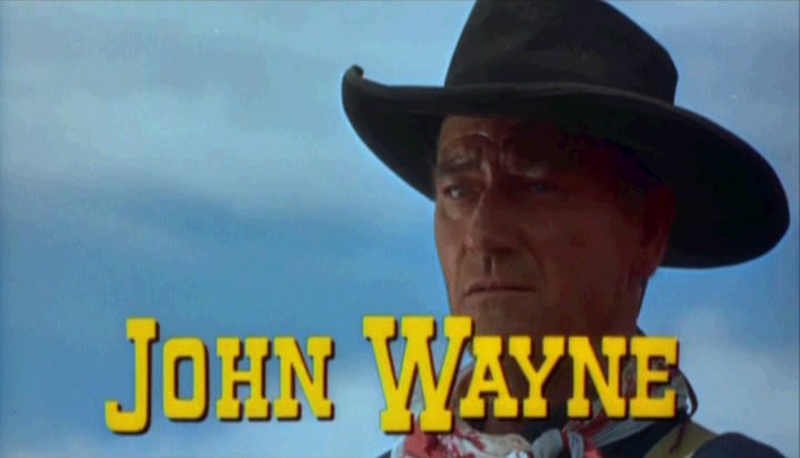
The film is unsparing in its depiction of the truth of this conquest. That the protagonist is played by the iconic John Wayne strengthens the natural impulse for an audience to identify with him. Yet as the film progresses, we gain an increasing awareness of his intense hatred of the Indians. We have been trapped into rooting for a racist. And one who wants to find the surviving kidnapped girl not to rescue but to kill her, because by now she has been sexually contaminated, in his view, “by livin’ with a buck.” But wait: this film is not an easy condemnation of one-way racism. Ethan’s racial hatred has a cause. Besides the recent murder of his brother and his brother’s wife and son and the discovery of the elder sister’s abused and mutilated body along the way, he apparently has experienced violence by Indians against his loved ones in the film’s hazy backstory. But wait again: we learn that his Comanche antagonist, Chief Scar, has as much reason to hate whites as Ethan has to hate Indians. Whites have killed two of his sons, we learn, and we sense that this is not the only outrage he has experienced against his people. To acknowledge that two groups that hate each other may both have cause (which is not the same as moral justification) has always been hard to do.
The honesty of Ford’s portrayal of this conflict goes even deeper. Ford doesn’t try to convey the Indians’ point of view by telling the story from their perspective. (Was he against cultural appropriation 70 years ahead of time?) We learn that it exists, and that it’s probably as rich in heartbreak as the one we’re following, but we can only imagine what stories the Comanche might tell in film if they possessed the technology and the culture needed to employ it. And the outcome of the conflict specific to the film is a microcosm of the general outcome in history. At the end, the US cavalry and deputized settlers raid Scar’s Comanche encampment and, the film implies, slaughter them all. The two cultures may be ethically equivalent, but they’re not evenly matched technologically, militarily, or demographically.
Ford attempts to resolve this impasse of racial hatred in a surprising way. First, just before the final, murderous raid, Martin, whom Ethan has derided and occasionally race-baited until now (although there are signs that Ethan has grown grudgingly fond of him), pleads for an opportunity to sneak into Scar’s camp before the raid so he can try to rescue Debbie. Martin knows, as does Ethan, that she is likely to be killed in the raid, either by Comanche or by the cavalry (which is fine with Ethan). To dissuade Martin, Ethan tells him that one of the scalps the two men had been shown in Scar’s tent was Martin’s mother’s. (How does Ethan know that, one wonders — another of the film’s backstory mysteries.) Ethan’s revelation fails to enrage Martin against the Comanche. Instead, Martin is angry at Ethan: “That don’t change nothin’!” Ethan relents. Unconvincing? What other answer is there to racial hatred, for which each side can find an endless supply of reasons and counter-reasons, than to just drop it? It shouldn’t matter. Martin, the product of miscegenation, is the film’s moral center. Perhaps his example is what inspires Ethan, after satisfying his bloodlust against Scar by scalping him and chasing down a terrified Debbie with murderous rage in his eyes, to lift her up tenderly and say, “Let’s go home, Debbie.” Unconvincing? Maybe. But what other resolution to racial hatred is there but a change of heart?
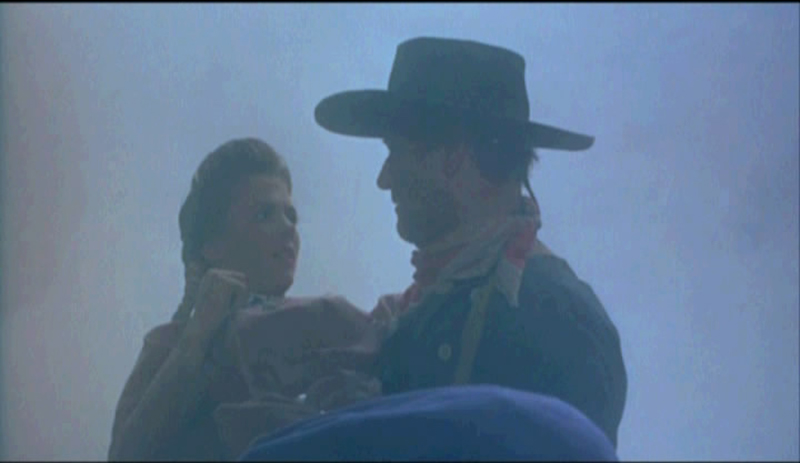
There’s much more to be said on behalf of this movie, but I have been interested here in the coexistence of so many flaws with so much greatness. An easy answer to this question is that the film’s strong points overcome its weak ones. The film is great in spite of its flaws. That might be true, but not particularly interesting. What I think but cannot prove is that film’s flaws and greatness are related. Not that they are connected directly. The film is not great because it is flawed. Or vice versa. Its flaws and its greatness are both the result of a third thing. He never articulated or intellectualized it, and he may not have been fully conscious of it, but Ford was groping in his largely intuitive way to get to a deep truth about the conquest of the West and about racial hatred, both of which troubled him. He was so focused on that, I suspect, and so totally without need to prove his directorial skill, that he didn’t want to let the little things get in the way. And if that’s case, I’m glad he didn’t. •
